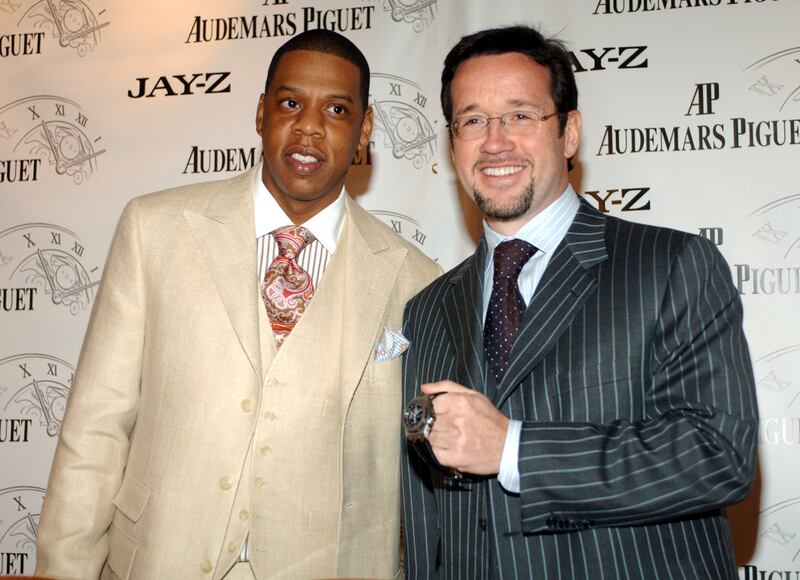
The Business of Fashion
Agenda-setting intelligence, analysis and advice for the global fashion community.

Agenda-setting intelligence, analysis and advice for the global fashion community.

Few figures in Swiss watchmaking have been as disruptive or as divisive over the past decade as François-Henry Bennahmias. In the 11 years since he was appointed chief executive of the family-owned Swiss watch company Audemars Piguet, an obsession with hip-hop and street culture, the launch of a new line called Code 11.59 and his leather bomber jackets have won him legion admirers — and as many detractors.
Next week, the 59-year-old Frenchman will walk out of the company’s headquarters in the sleepy village of Le Brassus for the last time, leaving a gaping hole not just in a company whose revenues have more than tripled during his tenure, but in an industry that’s short on high-flying mavericks. Few chief executives in the conservative watch world have reshaped the brands they run like Bennahmias. Have any made luxury watches as desirable? Since his departure was announced in 2022 observers have been left wondering not just what will become of AP, but of the wider industry, as well as what one of watchmaking’s greatest showmen will do next.
Sitting in a meeting room in the company’s New York offices, 29 storeys up, Bennahmias admits he’s running on fumes. In previous weeks, he’s been in Dubai and Geneva representing Audemars Piguet at large-scale events, and he’s just come from the launch of the brand’s latest high-octane, high-profile collaboration — with rapper Travis Scott’s brand Cactus Jack — at the brand’s 57th street boutique. The following week, he’ll be in Miami for Art Basel. And as I entered the office, I caught a glimpse of him in a glass-walled meeting room in deep conversation with actor Kevin Hart. (More on that in a moment.)
Bennahmias begins on slightly guarded form for a known performer whose expletive-laden speeches and unpredictable on-stage stunts have become familiar. At last month’s Grand Prix d’Horlogerie de Genève, he stunned the audience when he planted a kiss on the lips of unsuspecting French actor Edouard Baer, who was hosting the event.
ADVERTISEMENT
But with niceties out of the way, he quickly shifts up a gear. What makes now the right time to move on? He says he wanted to leave last year, having done 10 years at the helm and guided the company through the 50th anniversary of Royal Oak, AP’s flagship model, but that the board persuaded him to stay on another year.
“There are so many other things I want to do with my life before I die, and I want to be my own boss,” he shoots. “I’m not working for anyone ever again.”
His relationship with the Audemars Piguet board is thought to have been fractious at times as he stretched the company into new territories, leading where other Swiss brands might not dare to follow.
“They gave me the possibility to achieve what we’ve achieved together,” he says of his employers a touch evasively. “Were they always at ease with all my visions? No. Are they happy about what happened for the last 11 years? Sure. So it’s a balance.”
What has happened since he was appointed interim chief executive in 2012 is that AP has reported record-beating revenues 10 years out of the past 11 years (during the initial coronavirus outbreak in 2020, a 4 percent slip bucked the industry’s brand’s 21.4 percent norm), leapfrogging the brand ahead of rivals and, climbing the Swiss league tables. This year, Bennahmias forecasts revenues of 2.3 billion Swiss francs ($2.6 billion), a result which should cement its position in the top four Swiss watch companies behind Omega, Cartier and perennial chart-topper Rolex.
With success has come criticism: While his acolytes express unstinting loyalty, painting him as a visionary leader, those less enthused have accused him of undoing the traditions of the brand and currying favour from characters with questionable reputations. Scott, the latest example, narrowly avoided criminal charges after 10 people died at his Astroworld Festival in 2021, including a nine-year-old child. The star’s public response to the tragedy was widely condemned.
In spite of this, or perhaps because of it, Bennahmias’ impact on the watch industry has been seismic. Who else, many have asked, would have partnered a watch company founded in 1875 and revered by collectors for its arcane high-end complications with Marvel? Or Jay-Z? Or LeBron James? But his tenure saw watchmaking conquer a younger, global, more diverse audience as “at some point, street and luxury merged,” Bennahmias said.

Speculation about where one of the industry’s most charismatic figures will go next has been rife. Bennahmias has been tight-lipped, as has his inner circle. But as the day of his departure nears, the mask is falling.
ADVERTISEMENT
“I will never work for anyone else,” he says. “And I don’t see myself managing any businesses where the employees won’t be shareholders. I want every employee working for me to be a shareholder in the business.”
What that means exactly, is a detail beyond what he’s prepared to say. He lets on that he’s shown a deck to Kevin Hart and Tom Brady, both of whom were in New York for the Travis Scott launch. Apparently, they were taken by whatever it was they saw.
“Obviously, I’m going to stay in the field I know the best,” Bennahmias continues. “Luxury. Brands with a high perceived value.” But he won’t be drawn on whether that means starting his own brand or buying out an existing concept.
Thirty years ago, a career in watches looked unlikely for a man who’d come close to making a living as a professional golfer. In 1994, Bennahmias was working in fashion and on brands such as Giorgio Armani, Les Copains and Vilebrequin, when he was offered a job working for Audemars Piguet’s French office. In a 2019 interview, he admitted that at the time he’d never even heard of the Swiss watchmaker. He rose through the company ranks quickly, first running the Singapore office before, in 1999, he was appointed President and CEO of AP’s North American division, the role that would eventually propel him into the top seat of one of Switzerland’s few remaining family-run watch companies, first as interim and then permanently in 2013.
It was while in America that the Bennahmias’ model of pairing exclusive wristwatches with the world’s most glamorous and influential people in pop culture began in earnest. In 1999, he placed a Royal Oak Offshore on Arnold Schwarzenegger’s wrist in the film “End of Days,” and then a year later convinced some of the biggest names of the 1990s to take part in the Time to Give charity auction for the company’s 125th anniversary. Among others, Schwarzenegger was joined at Christie’s New York by Muhammad Ali, Whoopi Goldberg, Sharon Stone, Billy Crystal and Mariah Carey, seamlessly allying the brand to celebrity culture. “That,” says Bennahmias, “was the real turning point.”
By the time he travelled to AP’s home in the Swiss village of Le Brassus in 2004 carrying pictures of a pin-stripe-suited — as then — Sean “P.Diddy” Combs launching a fragrance with William Lauder, and a similarly dressed-up Jay-Z laughing with Prince Charles, Bennahmias was not only convinced the brand needed to dive into popular culture, particularly Black American culture, but also that he could convince his bosses to back him.
Whether the AP board knew he was on to something, or simply got swept up by the irrepressible energy of their enthusiastic protégé is unclear. Either way, they adopted Bennahmias’ plans, and in 2005 the Royal Oak Offshore Jay-Z 10th Anniversary Limited Edition was released, alongside an iPod pre-loaded with the artist’s back catalogue.
“It was not a tough negotiation,” Bennahmias recalls. “But they [the board] only wanted to do 100 pieces for the US, when we could have done 500. They wanted to see what was going to happen.”
ADVERTISEMENT

At the time, Bennahmias remembers AP’s annual revenues amounted to between 200 and 300 million Swiss francs. Did he believe a groundbreaking collaboration with a Black hip-hop artist would turn up the volume on AP sales? “We never did it to drive much more revenue,” he claims. “We never thought about it that way.”
Why do it then? “The goal was to raise the awareness of the brand,” he says. “I knew that doing something with Jay would open doors to many other things. And guess what? Athletes, other entertainers, musicians and comedians piggybacked on it. He opened the gates to a new world.”
In the years since, AP has either collaborated with or allocated watches to countless high-profile stars. A collaboration with LeBron James in 2013 came just as Bennahmias’ influence over the company as chief executive was beginning to show. Hart, Brady, Usher, Beyoncé, Stormzy, Ed Sheeran and Serena Williams — for many years the best-paid female athlete in the world — were among the many titans who became aligned to AP, sometimes as paid ambassadors, other times as customers only too happy to be seen wearing the brand.
And of course, the strategy – paired with more traditional tie-ups in golf and the arts – did drive revenues. By 2012, AP’s annual sales were reported to have reached 612 million Swiss francs, just over half those of Patek Philippe. In 2022, Morgan Stanley’s annual watch report estimated AP’s sales had more than tripled in 10 years to more than 2 billion Swiss francs, surpassing Patek’s 1.8 billion business. No other top Swiss watchmaker has known such growth over the same period. “There is always room to be innovative,” says Bennahmias. “Be creative, be daring – and it does work.”
Be creative, be daring – and it does work.
— François-Henry Bennahmias
His tone changes when asked about the current state of the watch market. He describes it as “untapped” and cites figures showing the industry’s total retail sales (circa $50 billion) still only amount to one third of those of Mercedes Benz.
“When you think about it, there’s still so much to achieve,” he says. What’s holding the industry back? “We’re still too shy,” he says. “Too risk averse. Too conventional.”
No matter its effects, there’s little sign of other brands overcoming their innate conservatism. Hublot, IWC and Zenith are among a small cohort with comparable strategies, but in the main, orthodox product and marketing strategies still dominate. Meanwhile, whether there’s a connection or not, global consumer appetite for Swiss watches has dimmed, with export volumes down around 40 percent since the mid-2010s. Export values are stalling, this year, too, as a post-coronavirus boom cools down, according to the Federation of the Swiss Watch Industry.
Some chief executives have responded to the downward trend with a shrug. Does Bennahmias think this is a problem? “Yes,” he says. “A big one.” If there’s a positive, he says, it’s in the troubled waters that might lie ahead. “I’m kind of happy that the business is gonna get tougher,” he says. “Because when it gets tougher, people get smarter. When everything is fine, it’s easy, but when you have to grind, it’s a different story and you think of things differently.”
Those things, he goes on, have to include distribution and the business of actually selling watches. In his mind, AP’s direct-to-consumer boutique strategy, including the confidential “AP House” concept deployed in many locations, has had far more impact on the company’s growth than its high-profile partnerships or even the appeal of the watches themselves.
“At the time, you could buy a single track on iTunes for 99 cents,” he says, recalling the landscape of 2012. “And for that, you’d give Apple your address, phone number and credit card information. Just to buy one song. I thought we were out of our mind selling watches for hundreds of thousands of Swiss francs and not knowing who our clients were. The big thing I did was to shrink the number of people between the watchmaker’s bench and the client.”
That tactic meant reducing the number of points of sale – and the size of the collection. He slashed references from around 900 to 200, a figure he says has since climbed back up to 300 in recent collections because of adding more high-end, low-volume or even one-off pieces.
If he makes these decisions sound simple, he says they weren’t. “There is no rule that because you do this it’s a success,” he says. “You never know what could happen. You’re always at risk.”
Indeed, there have been ups and downs for watchmaking’s disruptor-in-chief. In 2019, AP introduced Code 11.59, widely seen as a solution to the problem of being a “one-watch brand”, a criticism levelled at it because of the spectacular success of the Royal Oak, AP’s zeitgeisty 1970s sports watch and an industry icon.
But on the back of what many saw as a self-congratulatory launch, Code 11.59 was panned by critics and ridiculed on social media – and Bennahmias with it. The episode hit Bennahmias hard. How does he reflect on it? “Let’s put it this way,” he says. “I really do believe we’ve built something that’s going to last, now.” But did he always feel that way? “Not after the launch, but I never doubted that we would make it work. I always said it was a five-year launch. We won’t know if it’s successful for five years.”
And four years on, is it? “We are now making the biggest quantity for any collection outside the Royal Oak and it’s close to 13 percent of the business, which is substantial,” he says. “And I know we have some unbelievable innovations in the pipe, too.”
Last month, Bennahmias was visibly emotional when he stepped on stage at the Grand Prix d’Horlogerie de Genève, the industry’s most prestigious awards ceremony, to collect the Aiguille d’Or, the top prize on the night, for the Code 11.59 Universelle RD#4, a $1.9 million version of the watch with 23 complications.
“It felt really, really good,” he admits. “Don’t forget I’m a competitor. People think that because it’s successful, it’s always a big smile and happiness and everything. But it’s not, and I understand why more, now: some people reach those levels and they deal with mental health issues or big downs or depressions. And so when they win, it’s tough.”
If he’d had his way and left a year ago, the prize would have been collected by his successor. On January 1, the former Procter and Gamble executive Ilaria Resta will take over as AP’s new chief executive. She joined the company in August and has been shadowing Bennahmias, learning the ropes as she takes on one of the biggest jobs in watchmaking – and her first. “If they [the board] had appointed someone from inside the industry, I would have been gone in two seconds,” says Bennahmias, who describes Resta as his “younger sister” and “a good human being with great human skills.”

So, will he miss the job that has defined his career? At this point he pauses. “I leave with zero regret – I cannot wait actually to be done,” he says. “We had an outstanding ride. Even when we were tired, there was always something good about it. What I miss already is what we put together as human beings. And I’m going to recreate that somewhere else for sure.”
From the outside, he’ll be remembered for linking the rigid world of Swiss watchmaking to iconoclasts of contemporary Black American culture and the unapologetic bombast with which he did so. The changes he’s affected at AP and in the industry are captured in his own appearance: As he says, in 2005, he dressed “like a banker”, in three-piece suits and with rimless glasses. Now, his uniform is black jeans, sneakers and tees daubed with streetwear logos and slogans. His influence over the company’s growth won’t quickly be forgotten either.
But how would he like to be remembered? “A great leader,” he says. “I don’t care about revenues or profitability. They’re always a consequence of great strategy and great leadership.”
Audemars Piguet will go on. Is it ready for life without him? “There is no answer to that,” he says. “I could say, I hope so. I could say, I think so. I’m gonna say only time will tell.”
In partnership with Scott, Audemars Piguet is set to release a limited-edition version of its Royal Oak watch and a capsule collection of co-branded merchandise from the watchmaking house and Cactus Jack Records.
Strong demand for the Swiss luxury watch brand’s pricey timepieces has put sales on track to hit fresh highs.
The brand known for $50,000 Royal Oak watches transformed itself into a megabrand with more than $2.2 billion in annual sales by taking control of its distribution and forging culturally relevant partnerships. Outgoing CEO François-Henry Bennahmias breaks down the strategy.
The designer has always been an arch perfectionist, a quality that has been central to his success but which clashes with the demands on creative directors today, writes Imran Amed.
This week, Prada and Miu Miu reported strong sales as LVMH slowed and Kering retreated sharply. In fashion’s so-called “quiet luxury” moment, consumers may care less about whether products have logos and more about what those logos stand for.
The luxury goods maker is seeking pricing harmonisation across the globe, and adjusts prices in different markets to ensure that the company is”fair to all [its] clients everywhere,” CEO Leena Nair said.
Hermes saw Chinese buyers snap up its luxury products as the Kelly bag maker showed its resilience amid a broader slowdown in demand for the sector.